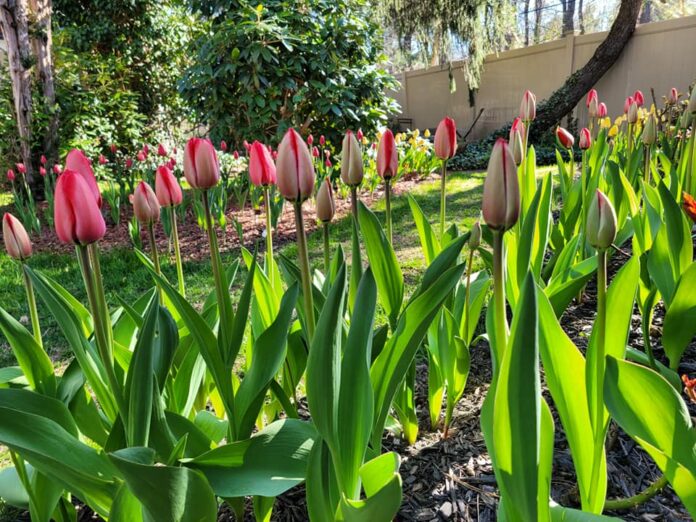By Upendra Mishra
WESTON, MA—The fresh smell of the ground, layers of varied colors, sweet-smelling flowers on apple and other trees, wildflowers coming to life, quietly melting snow in the pond, gushing water in the narrow water stream and that sweet and relaxing sounds of waterfalls, microscopic buds and leaves sprouting all over. Day light extending and darkness of the cold winter nights slowly shrinking, and the temperature warming up steadily.

As the plants and flowers emerge from their winter slumber, so do the bugs, insects, butterflies, bees, frogs, snakes, pollinators, and all kinds of creatures. Suddenly, there is so much action in the garden, and so much food for everyone. Nothing goes to waste in Mother Nature. Nothing. Not even the fallen leaves and branches from winter storms.
That is how spring starts in the Mishra Garden every year.
I am sure you may have observed some of these phenomena in your own backyard and garden, in your flower beds and pots, in your container gardens, in your neighborhood parks and along walking trails, or whenever you are driving by across New England during spring season. All we need to do to experience spring is look around and observe the changing tapestry of Mother Nature unfolding everywhere.
Even before the snow melts, I start salivating about the future flowers in my garden beds, and plants breaking out of the ground, thinking about which rose would have survived this winter, which one will die, and which ones would get stronger. It seems these flowers and plants, their color and fragrance, their texture and their locations in my garden have been seeply imprinted in my head by Mother Nature. I can easily recall most of the plants, their locations, colors and even fragrance. Sometimes, I wish I could give them a name and call them by their names.
In my remote village of Purnachhapar in Eastern Uttar Pradesh in India, every mango tree had a name. In fact, my family had three big mango orchards, and they were also named: Khalihanwa (where all the seasonal harvests would be collected under mango and jackfruit trees), Nadi Par (on the bank of the river), and Badki Bari (the big orchard.) Here in The Mishra Garden, I have also divided it in several sections and have named them appropriately, depending on the types of flowers and structure of the garden. One section is called La Romantica, one part is named Silsila Garden, one part is called El Amor, and of course there is a Buddha Garden. All the roses come with their own names: Love, Opening Night, Double Delight, Fragrant Cloud, Tahitian Sunset, Pope John Paul II, Peace, Daring Spirit, Mister Lincoln, JFK, and Chicago Peace, among others.
In my village, too, every mango tree in my orchards had their names: Dhamakawa (when a mango would fall from that tree, it would make a dham sound), Senuria (all mangoes from this tree were orange-red color). Some trees were named based on the intensity of sweetness (Mithkoia) and some were named based on the age of the tree and some on the size of the mango fruit they produced. Even the jackfruit plants had their names.
After leaving India in early 1984, I still remember the spring season of my village. Ever since I started to remember things, spring was the same every year in my village. Walking to school barefoot during the spring was enchanting. The ground had warmed up. No cold feeling underneath our feet in winter months, and not those hot pathways of the scorching summer season without shoes or sandals. The weather in spring would quickly warm up, the swaths lush green wheat fields would stretch from one end to another and would be endless, carpets of yellow mustard flowers could be seen everywhere, and Ah! The flowering of the mango trees and their intense smell still blossom in my memory.
The quiet celebration of Vasant Panchami festival had also become a quiet spring ritual in my village, especially for us young souls who believed that Saraswati, the Goddess of knowledge and learning, would make us pass our school exams with high marks. At that time, I could not connect Goddess Saraswati with the beautiful spring. Now, however, I think that the favorite yellow color of Goddess Saraswati symbolized the yellow mustard flowers. On that special Vasant Panchami day, we would try to wear new yellow clothes; if not new, old would work and if there we no yellow attire, Mother Nature had already produced yellow color through mustard flowers all across the fields.
This would also be the beginning of the Holi festival when most of the crops will be ready for harvesting, and us kids would be impatiently waiting for the festival of colors. The spring of my village still brings back all those memories here in The Mishra Garden.
Coming back to The Mishra Garden, I must confess that I still hanker for the Purnachhapar spring. I have learned, however, to enjoy what I have now. It is hard, but spring in The Mishra Garden is all that I have now. It keeps reminding me of my childhood springs. I realize that gardening is not only about planting flowers and vegetables, but it has a lot to do with our memories associated with plants and trees, and our parents, grandparents and all family members and friends.
After moving from one village to another and from one town to another in India, and then living in so many places overseas, I finally feel now that I have re-rooted myself here—just like many of the plants, trees, and flowers that I have planted. I have spent over 25 years in The Mishra Garden, and I finally realize that this is the place where I belong now. Do I still crave for the Purnachhapar spring? Yes, I do but I know in my heart that no one can take that little Purnachhapar spring away from my soul.
Spring in The Mishra Garden has also become an annual ritual now. Soon after the snow melts, I start looking at the ground, enjoying sprouting of early bulbs and tulips, other plants emerging and then all of sudden a beautiful garden emerges from nowhere. I replace dead roses and other plants, find places for new plants, clean pathways and enjoy the garden changing every day. Because of the longer days, the plants grow so fast here. I feel as if I am experiencing a new garden every day. There is always something new in the garden every day.
As the temperature rises further, the texture, flowers and plants look so different during the summer. By the fall, some plants have grown, flowered, fruited and completed their life full life cycle; some would go to sleep during frigid New England winter to come back again in the next spring. Everything is unfolding as it should.
Happy Spring and Happy Gardening!
(Mr. Mishra is managing partner of the Waltham, MA-based integrated inbound marketing and PR firm The Mishra Group. He writes about his three passions: marketing, scriptures, and gardening.)














